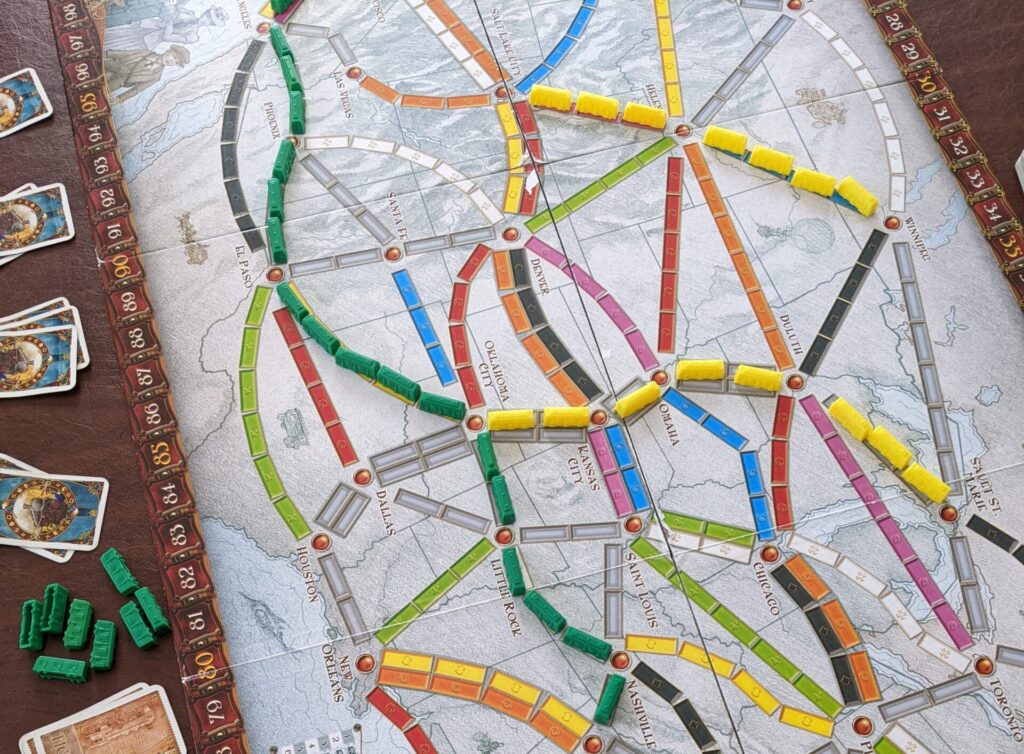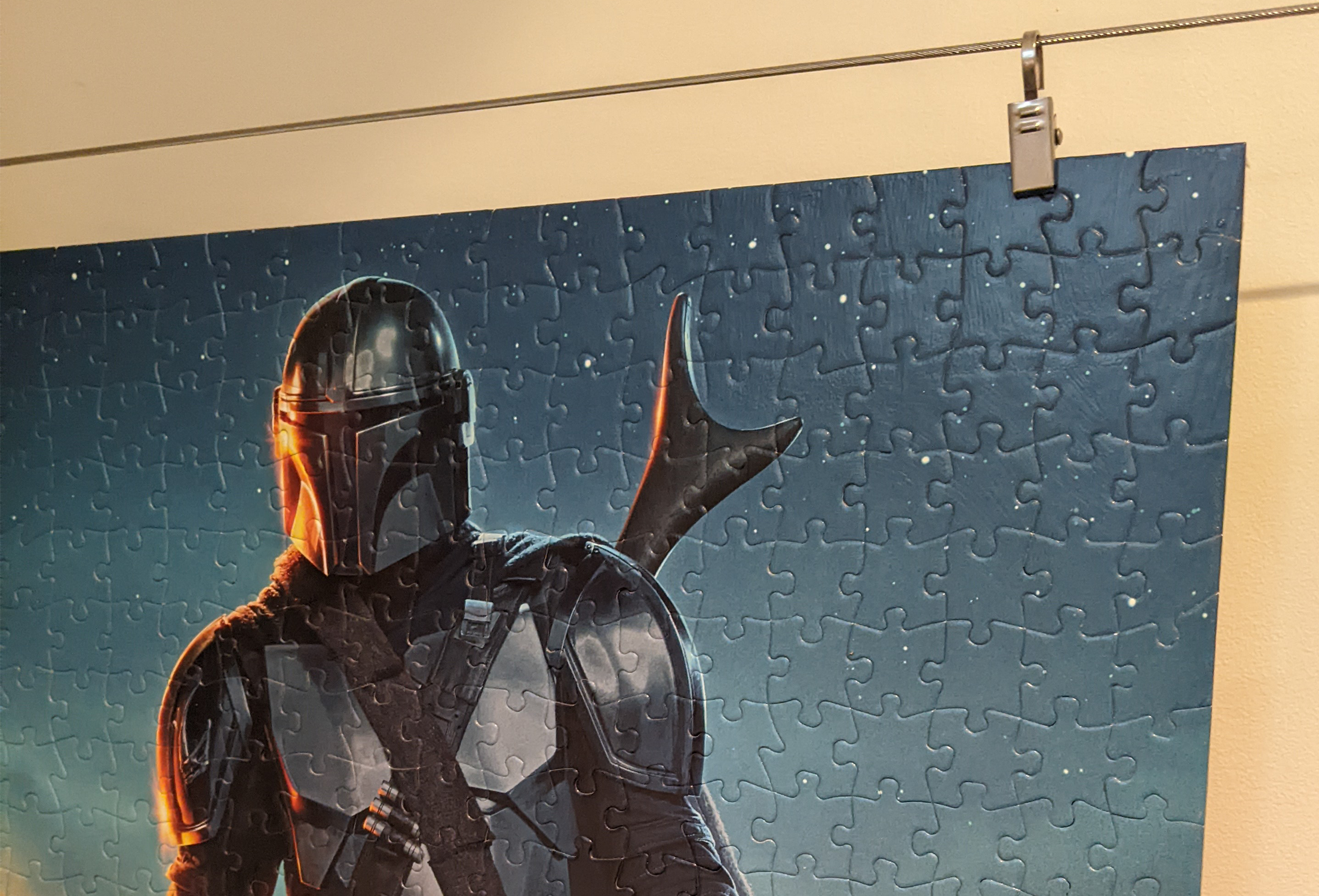Pieces and Puzzles
By Kelly Paulson
My husband gave me a new puzzle. It’s a picture of the Earth from space. It’s intimidating. It’s round (thus curved edges), 1,000 odd-shaped pieces, lots of blue, lots of textured white, and, full disclosure, only ⅓ complete and still scattered across the coffee table.
I have another puzzle… my son. He doesn’t look like me (red hair). He doesn’t think like me; in fact, he doesn’t think like a lot of us. But how he thinks doesn’t make him any more messy; he’s just a few unique pieces to put together.
My son is autistic. He has challenges related to communication, attention, and understanding of social situations, among other things. He’s also bright, funny, and kind. An autism “label” comes with stereotypes and preconceived ideas of what autism looks like. To me, it looks like a young man who is growing up in what can be an overwhelming world, and he has his own ways to cope with its stresses and to add to its charm.
We try to encourage my son to try different activities. If it were up to him, he might play video games while simultaneously watching YouTubers play video games hour after hour. [See above: He doesn’t think like me.] But we encourage puzzles and family games as one of many breaks in that compulsion.
At EdGE, we’re thinking about how to support executive function (EF) in neurodiverse learners. EF is the attention-regulation processes involved in goal-directed problem solving. Children (and adults) may struggle with impulse control, emotional control, flexible thinking, working memory, self-monitoring, planning and prioritizing, task initiation, and organization. I think of this from the parent perspective as well. Some of the puzzles and games that we enjoy support some of these EF skills.

Ticket to Ride is one of those games, and it’s also really fun. If you’re not familiar with it, the game involves creating train routes, based on selected cards, to get to chosen destinations on tracks also coveted by other players. My son loves this game. We play it often, I think we played every day through the early pandemic… talk about burnout. We no longer play with Dad though; he goes too slow. My son’s method of play, developed over time, is Speed Ticket to Ride. He knows the routes, he knows what cards he has in his hand, and he has one objective… to get the longest route. And with only two people playing, he can often do this.
Where does the EF come in? This train engineer struggles with impulse control. So even knowing he had 5 train cars left, he would still make a choice to take 3 more routes off the deck. It took much patient training to remind him that he couldn’t put them back if they didn’t work for him, if they didn’t cover the routes he already had. But we powered through, like we do so often, and once again, game play became a learning experience for life… you don’t always get what you want. He’s had to practice flexible thinking, change his assumptions, and regulate his emotions when presented with a new problem or an unpreferred outcome.
My son also has an incredible memory. So while not working on his “working memory,” this game allows him to be successful and shine. He knows what color cards he has… separated in piles (sorted), randomly scattered but remembered. And that recognition of “you can do it” success is my goal.
So back to the puzzle… okay, puzzles are not his favorite, which is funny because he loved floor puzzles when he was little… trains, trucks, big easily manipulated pieces. Now, when he does a puzzle, he can be distracted. Is it the smaller, not as easily manipulated pieces? Is it the overwhelming task in front of him? It helps to recognize the challenges to foster engagement and get to the point of the activity in the first place: time together, time off screens, time thinking, time engaging. It helps him when the puzzle image is something he is invested in or can relate to. Earth from above, not so much; Mandalorian or Baby Yoda, he’s all in.
But he’s worked with me on the Earth puzzle. If we’re working on supporting executive function, this is one way to practice perseverance! Recently, he put two pieces together that obviously didn’t fit. Very funny, I joked and he laughed. So he repeated that joke multiple times to get a response, and I, like any good, patient mother, kept it up. He kept at it but also stayed with me. And while we joked through the mismatches, I kept up a steady stream of questions: How could we find the right pieces? How could we group or organize the pieces so they were easier to find? What could we try first, then do second? And so on. The EdGE team incorporates these questions to ponder while puzzling in Jigsaw Puzzles: An Introduction to CT, perfect for classroom educators and parents.
Intimidating for anyone is 1,000 pieces that all look the same and you need to put them back together. By capitalizing on my son’s strengths of organizing, we worked on separating the pieces into color groups. It was an exercise in persistence and one more step toward problem solving.
For those interested in more, some games we’ve explored just for fun and that the internet recommends to support and build EF skills.
- Blokus
- Rat-a-Tat Cat
- Qwirkle
- Jenga
- Mastermind
- Ticket to Ride
Time spent together is important. Time spent with fun games that help develop social skills and EF growth is even better.
For more on Kelly’s experience with a neurodiverse thinker: https://blog.terc.edu/autism-acceptance-month
My husband gave me a new puzzle. It’s a picture of the Earth from space. It’s intimidating. It’s round (thus curved edges), 1,000 odd-shaped pieces, lots of blue, lots of textured white, and, full disclosure, only ⅓ complete and still scattered across the coffee table.
I have another puzzle… my son. He doesn’t look like me (red hair). He doesn’t think like me; in fact, he doesn’t think like a lot of us. But how he thinks doesn’t make him any more messy; he’s just a few unique pieces to put together.
My son is autistic. He has challenges related to communication, attention, and understanding of social situations, among other things. He’s also bright, funny, and kind. An autism “label” comes with stereotypes and preconceived ideas of what autism looks like. To me, it looks like a young man who is growing up in what can be an overwhelming world, and he has his own ways to cope with its stresses and to add to its charm.
We try to encourage my son to try different activities. If it were up to him, he might play video games while simultaneously watching YouTubers play video games hour after hour. [See above: He doesn’t think like me.] But we encourage puzzles and family games as one of many breaks in that compulsion.
At EdGE, we’re thinking about how to support executive function (EF) in neurodiverse learners. EF is the attention-regulation processes involved in goal-directed problem solving. Children (and adults) may struggle with impulse control, emotional control, flexible thinking, working memory, self-monitoring, planning and prioritizing, task initiation, and organization. I think of this from the parent perspective as well. Some of the puzzles and games that we enjoy support some of these EF skills.

Ticket to Ride is one of those games, and it’s also really fun. If you’re not familiar with it, the game involves creating train routes, based on selected cards, to get to chosen destinations on tracks also coveted by other players. My son loves this game. We play it often, I think we played every day through the early pandemic… talk about burnout. We no longer play with Dad though; he goes too slow. My son’s method of play, developed over time, is Speed Ticket to Ride. He knows the routes, he knows what cards he has in his hand, and he has one objective… to get the longest route. And with only two people playing, he can often do this.
Where does the EF come in? This train engineer struggles with impulse control. So even knowing he had 5 train cars left, he would still make a choice to take 3 more routes off the deck. It took much patient training to remind him that he couldn’t put them back if they didn’t work for him, if they didn’t cover the routes he already had. But we powered through, like we do so often, and once again, game play became a learning experience for life… you don’t always get what you want. He’s had to practice flexible thinking, change his assumptions, and regulate his emotions when presented with a new problem or an unpreferred outcome.
My son also has an incredible memory. So while not working on his “working memory,” this game allows him to be successful and shine. He knows what color cards he has… separated in piles (sorted), randomly scattered but remembered. And that recognition of “you can do it” success is my goal.
So back to the puzzle… okay, puzzles are not his favorite, which is funny because he loved floor puzzles when he was little… trains, trucks, big easily manipulated pieces. Now, when he does a puzzle, he can be distracted. Is it the smaller, not as easily manipulated pieces? Is it the overwhelming task in front of him? It helps to recognize the challenges to foster engagement and get to the point of the activity in the first place: time together, time off screens, time thinking, time engaging. It helps him when the puzzle image is something he is invested in or can relate to. Earth from above, not so much; Mandalorian or Baby Yoda, he’s all in.
But he’s worked with me on the Earth puzzle. If we’re working on supporting executive function, this is one way to practice perseverance! Recently, he put two pieces together that obviously didn’t fit. Very funny, I joked and he laughed. So he repeated that joke multiple times to get a response, and I, like any good, patient mother, kept it up. He kept at it but also stayed with me. And while we joked through the mismatches, I kept up a steady stream of questions: How could we find the right pieces? How could we group or organize the pieces so they were easier to find? What could we try first, then do second? And so on. The EdGE team incorporates these questions to ponder while puzzling in Jigsaw Puzzles: An Introduction to CT, perfect for classroom educators and parents.
Intimidating for anyone is 1,000 pieces that all look the same and you need to put them back together. By capitalizing on my son’s strengths of organizing, we worked on separating the pieces into color groups. It was an exercise in persistence and one more step toward problem solving.
For those interested in more, some games we’ve explored just for fun and that the internet recommends to support and build EF skills.
- Blokus
- Rat-a-Tat Cat
- Qwirkle
- Jenga
- Mastermind
- Ticket to Ride
Time spent together is important. Time spent with fun games that help develop social skills and EF growth is even better.
For more on Kelly’s experience with a neurodiverse thinker: https://blog.terc.edu/autism-acceptance-month

7/12/23
AuthorKelly Paulson writes about lived experience through the lens of a former educator and current parent of a neurodiverse child. She works with the EdGE at TERC team, a research and development group exploring the intersection of STEM and neurodiversity.
SummaryA mother’s perspective on supporting the executive function of her neurodiverse child using puzzles and board games.
Share This Page: